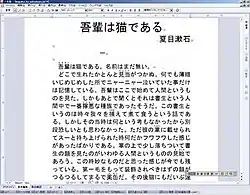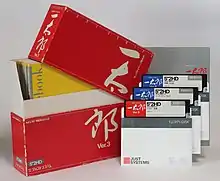Ichitaro (word processor)
Ichitaro (一太郎, ichitarō) is a Japanese word processor produced by JustSystems, a Japanese software company. Ichitaro occupies the second share in Japanese word-processing software, behind Microsoft Word. It is one of the main products of the company. Its proprietary file extension is ".JTD". ATOK, an IME developed by JustSystems, is bundled with Ichitaro.
 | |
| Developer(s) | JustSystems |
|---|---|
| Stable release | Ichitaro 2019 (29.0)
/ 8 February 2019 |
| Operating system | Microsoft Windows |
| Type | Word processor |
| License | Proprietary |
| Website | www |
In the DOS era, Ichitaro had a considerable market share along with other rivals. However, as Windows became dominant, the market was largely taken over by Microsoft Word.[1]
Origin of name
"Taro (太郎)" was named by Kazunori Ukigawa (浮川 和宣), a founder of JustSystems. When he worked part-time as a tutor, one of his learner's name was Taro. He died sick when Kazunori worked at the company. Taro is also a common Japanese given name used for the eldest son.[2] Sanyo Electric already had a trademark right of the name,[3] so JustSystems added a prefix "Ichi (一)" as they hoped the software won the best.[4]
History
Beginnings
JustSystems was founded in July 1979 by Hatsuko (初子) and Kazunori Ukigawa, and was incorporated in June 1981. Kazunori worked at a subsidiary company of Toshiba, and he was interested in Japanese-language computing. Toshiba released JW-10 in February 1979, the first word processor for the Japanese language, but it sold less than their business computers. He founded the company as a dealer of business computers, and they started selling Japanese language software. After the release of PC-8801, they developed an invoicing software for it, which printed out estimations and invoices in Japanese. They demonstrated it at trade fairs, and received a positive response.[2]
When they contacted to ASCII Microsoft about a run-time license fee of the BASIC compiler used for their farm management software, ASCII had known JustSystem's Japanese software, so they asked JustSystems to develop a Japanese word processor software for PC-100. It was released as JS-WORD in 1983. It was followed by JS-WORD 2.0 ported for PC-9801. Both were published by ASCII under their name. JS-WORD featured mouse support and a graphical icon-based interface, but it resulted in poor performance.[5] The jX-WORD for the IBM JX was released and in 1985, jX-WORD Taro was released for PC-9801. jX-WORD Taro was priced at 58,000 yen, which was the middle price among Japanese word processor software, and sold 9,700 copies.[2][6]
Domination in Japan PC market


The same year, Ichitaro was released as its definite successor. Ichitaro's system disk contained ATOK 4 and a runtime version of MS-DOS 2.11. It allowed users to use other MS-DOS applications with Japanese language support.[6] The biggest competitor, Matsu (松), was released in 1983 by Kanri Kougaku Kenkyujo (管理工学研究所). It gained speed from being written in assembly language and natively ran on PC-9801, but Matsu's Japanese input method couldn't use for other applications. Ichitaro had plenty of typesettings options, but Matsu did not. Also, Matsu was priced at 128,000 yen before Ichitaro came out.[7]
The first version of Ichitaro has shipped 29,000 copies. Ichitaro Ver.2 has shipped 80,000 copies. Ichitaro Ver.3 was the first version ported for other Japanese DOS platforms. It has shipped more than 300,000 copies until 1991. Total shipments of Ichitaro reached one million in November 1991.[6] Contrary to the Japanese personal computer market expanding into beginners, Matsu oriented for power users, so Ichitaro overtook it.[7]
Ichitaro Ver.4 was released in April 1989. It had a proprietary operating environment called Just Window (ジャストウィンドウ), like Lotus Symphony. Three minor versions were released because it was buggy. The stable version was 4.3 released in December 1989.[2][8] ATOK 7 was bundled with Ichitaro 4, and was available as a standalone product in 1992.[9]
Arrival of Microsoft Word
Microsoft released the first Japanese version of Microsoft Word for Windows in 1991. Four years passed before Ichitaro 5 was released for Japanese DOS platforms in April 1993. The next month, Microsoft released the Japanese Windows 3.1 and the first Japanese version of Microsoft Office, which included Word 5.0 and Excel 4.0.[10] Its successors shipped 200,000 copies per month in late 1994.[11] JustSystems barely completed a Windows adaptation of Ichitaro in December 1993,[12] but Microsoft took over the market dominated by Ichitaro and Lotus 1-2-3.
As of 1997, a Japanese media website reported that 64 percent of readers using Microsoft Word, and the main reason was that they used it in offices and schools. The rest of 35 percent were using Ichitaro, and the main reason was that the IME of ATOK was convenience.[13]
In 1998, the Japan Fair Trade Commission informed Microsoft of an unfair trade that they forced personal computer manufacturers to bundle with Excel and Word against the request of a bundle with Excel and Ichitaro.[14]
Ichitaro Ver.5 was ported to the Macintosh and to OS/2. In May 2003, the release of a Linux version was announced. Compact versions, "Ichitaro dash" and "Ichitaro lite" are produced for laptop PCs. As office suite, "Just home" is also available. "Ichitaro smile" is targeted at elementary school students and "Ichitaro jump" at middle and high school students.
On 1 February 2005, sales and production of the software were frozen pending an appeal by the company against a ruling of the Tokyo District Court which states that there is a breach of a patent owned by Matsushita Electric Industrial Co., Ltd.[15] However, on 30 September 2005, Intellectual Property High Court of Japan, which was newly formed in April 2005, has granted JustSystems’ appeal. Because this judgement became a final decision in October 2005, the original decision sentenced by the Tokyo District Court was overturned.[16]
In 2009, JustSystems became a subsidiary company of Keyence. In the 2010s, they focus on correspondence education and enterprise software although Ichitaro and ATOK continue to be developed.[17]
Versions
| Version | Release Date | Notes |
|---|---|---|
| JS-WORD | October 1983 | For PC-100, published by ASCII under their name |
| JS-WORD 2.0 | May 1984 | For PC-9800 series, published by ASCII |
| jX-WORD | December 1984 | For IBM JX series |
| jX-WORD Taro | February 1985 | For PC-9800 series |
| 1 | 28 August 1985 | Allow the use of ATOK from other applications |
| 2 | May 1986 | |
| 3 | June 1987 | No disk copy protection from this version[6] |
| 4 | April 1989 | Three minor versions exist, 4.1, 4.2, and 4.3[8] |
| 5 | April 1993 | Mac version released in July 1995 |
| 6 | January 1995 | Version 6.3 (August 1995) included internet connectivity |
| 7 | September 1996 | Windows 95. Dropped support for Windows 3.1 |
| 8 | February 1997 | |
| 9 | September 1998 | All versions from here use .jtd extension |
| 10 | September 1999 | |
| 11 | February 2001 | |
| 12 | February 2002 | Dropped support for Windows 95 |
| 13 | February 2003 | |
| 14 | February 2004 | Ichitaro 2004 |
| 15 | February 2005 | Ichitaro 2005 |
| 16 | February 2006 | Ichitaro 2006 |
| 17 | 9 February 2007 | Ichitaro 2007. Dropped support for Windows 98 and Me |
| 18 | 8 February 2008 | Ichitaro 2008 |
| 19 | 6 February 2009 | Ichitaro 2009. Windows 7 |
| 20 | 5 February 2010 | Ichitaro 2010. Dropped support for Windows 2000 |
| 21 | 10 February 2011 | Ichitaro 2011 Sō (創) |
| 22 | 10 February 2012 | Ichitaro 2012 Shō (承) |
| 23 | 8 February 2013 | Ichitaro 2013 Gen (玄).[18] DRM activation implemented[19] |
| 24 | 7 February 2014 | Ichitaro 2014 Tetsu (徹) |
| 25 | 6 February 2015 | Ichitaro 2015. Dropped support for Windows XP |
| 26 | 5 February 2016 | Ichitaro 2016 |
| 27 | 3 February 2017 | Ichitaro 2017. Dropped support for Windows Vista |
| 28 | 9 February 2018 | Ichitaro 2018 |
| 29 | 8 February 2019 | Ichitaro 2019 |
Security
In 2013, Symantec revealed that Ichitaro had the potential to be targeted by trojan horse programs.[20] A gang of Chinese hackers was widely blamed for the incident.[21]
Further reading
- 2005 (Ne) 10040 Appeal Case of Seeking Injunction against Patent Infringement - the Intellectual Property High Court of Japan
References
- The Yomiuri Shimbun, pp.9 Tokyo morning edition, 8 April 1998.
- "「一太郎」が知っているPC-9801シリーズの軌跡". 蘇るPC-9801伝説 永久保存版 第1弾 (in Japanese). ASCII. 2004. pp. 87–92. ISBN 4-7561-4419-5.
- 関口, 和一 (6 March 2000). ""一太郎の産声"". パソコン革命の旗手たち. Nihon Keizai Shimbun. pp. 118-123. ISBN 4-532-16331-5.
- "一太郎Web:一太郎ヒストリー 一太郎". 一太郎Web. JustSystems. 1 September 2010. Retrieved 31 March 2019.
- 国友, 正彦 (1989). "最新日本語入力FP対決 ATOK 7 VS VJE-β Ver.2.1". ASCII (in Japanese). 13 (9): 249–256. ISSN 0386-5428.
- "一太郎累計出荷本数". マイコン. 電波新聞社. 16 (2): 159. 1992. ISSN 0387-9593.
- 片貝, 孝夫; 平川, 敬子 (1988). "日本語ワードプロセッサの歴史". パソコン驚異の10年史―その誕生から近未来まで (in Japanese). Kodansha. pp. 55–85. ISBN 4-06-132721-6.
- "一太郎Web:一太郎ヒストリー 一太郎Ver.4". 一太郎Web. JustSystems. 1 September 2010. Retrieved 31 March 2019.
- "先進の日本語システム「ATOK」の進化". JustSystems. 23 October 1998. Archived from the original on 2 February 1999. Retrieved 22 April 2019.
- "マイクロソフト、ウィンドウズ3.1対応ソフト―パッケージを投入". Nikkei Sangyo Shimbun. 17 June 1993. p. 6.
- "マイクロソフト、「オフィス」「ワード」増産―倍の月20万本に。". Nikkei Sangyo Shimbun. 18 October 1994. p. 6.
- "ジャストシステムが日本語Windows3.1用の一太郎を発表". ASCII. 17 (11). 1993. ISSN 0386-5428.
- "プレゼント付き読者アンケート第16回「対決!?一太郎 VS Microsoft Word」集計結果発表". Impress PC Watch. 26 March 1997. Retrieved 24 April 2019.
- "公正取引委員会、マイクロソフトへの勧告内容をPDFファイルで公開". Impress PC watch. 24 November 1998. Retrieved 31 March 2019.
- The Yomiuri Shimbun, pp.1 Tokyo morning edition, 2 February 2005.
- The decision of case 2005 (Ne) 10040, Intellectual Property High Court of Japan - 30 September 2005
- 島, 大輔 (5 March 2017). "あのジャストシステムが大変貌を遂げていた―今や収益柱は「一太郎」「ATOK」ではない". Toyo Keizai. Retrieved 31 March 2019.
- "ニュースリリース 2012.12.04 書き手の感性を刺激し、より深みのある表現へと導く「一太郎2013 玄」を来年2月8日(金)より発売". JustSystems. 4 December 2012. Retrieved 31 March 2019.
- "ネットジャパン製品 FAQ - powered by phpMyFAQ 1.4.11". NetJapan. 21 May 2013. Retrieved 31 March 2019.
- Symantec: "Yet Another Zero-Day: Japan Hit with Ichitaro Vulnerability", 14 November 2013. Accessed 3 March 2014
- "New York Times hackers linked to Japan Ichitaro attacks", The Register, 18 November 2013. Accessed 3 March 2014